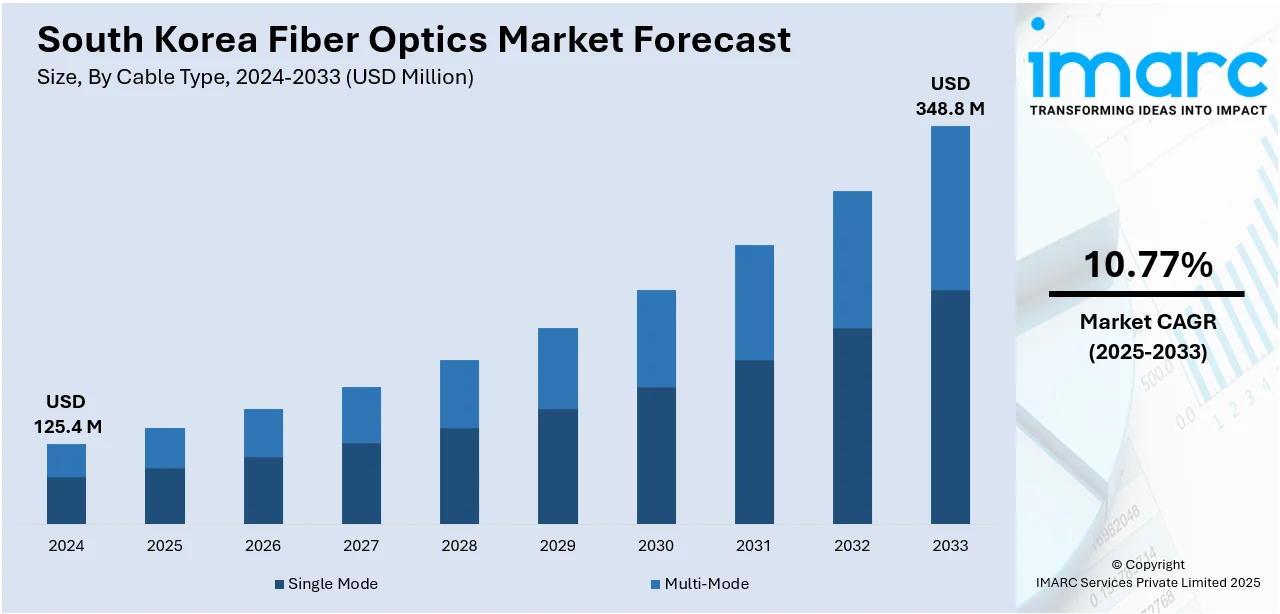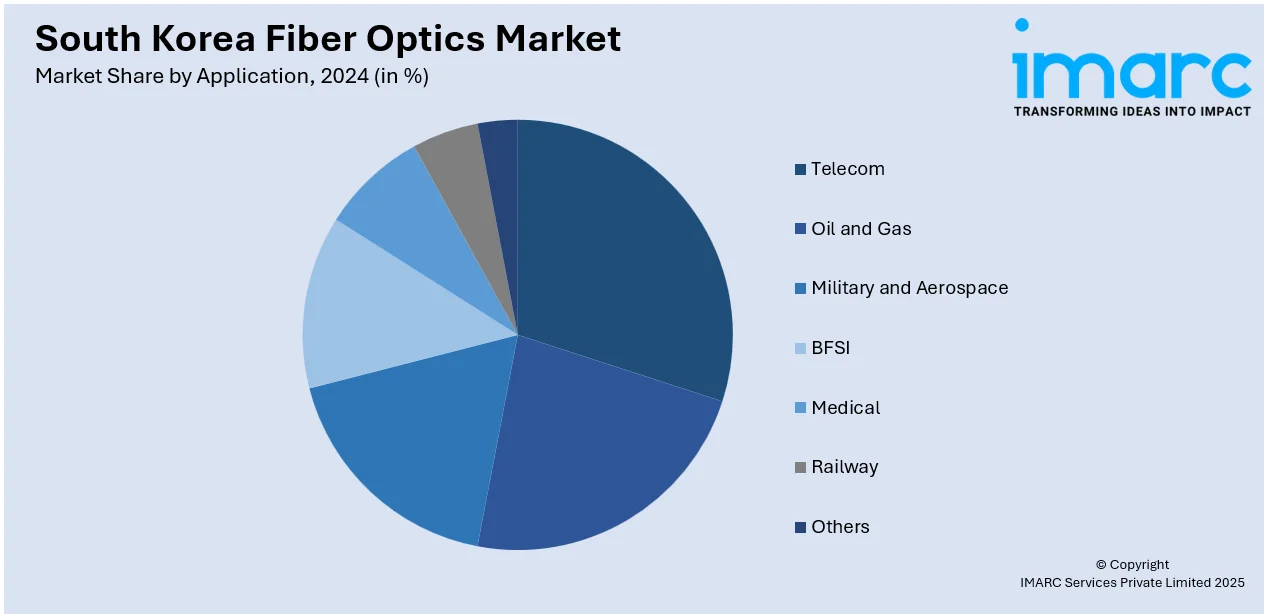
South Korea Fiber Optics Market Size, Share, Trends and Forecast by Cable Type, Optical Fiber Type, Application, and Region, 2025-2033
South Korea Fiber Optics Market Overview:
The South Korea fiber optics market size reached USD 125.4 Million in 2024. The market is projected to reach USD 348.8 Million by 2033, exhibiting a growth rate (CAGR) of 10.77% during 2025-2033. The market is expanding due to rising investments in high-speed internet infrastructure and 5G deployment. In addition, growing demand for FTTH connectivity and cloud-based services continues to support South Korea fiber optics market share across telecom, residential, and enterprise network segments.
|
Report Attribute
|
Key Statistics
|
|---|---|
|
Base Year
|
2024
|
|
Forecast Years
|
2025-2033
|
|
Historical Years
|
2019-2024
|
| Market Size in 2024 | USD 125.4 Million |
| Market Forecast in 2033 | USD 348.8 Million |
| Market Growth Rate 2025-2033 | 10.77% |
South Korea Fiber Optics Market Trends:
Rising Demand from 5G and Data Centers
The South Korea fiber optics market growth is gaining strong momentum due to the rapid expansion of 5G networks and increased reliance on high-speed internet infrastructure. With major telecom providers deploying advanced mobile networks, there is a growing need for a robust fiber optic backbone to handle the surge in data traffic. Fiber optics offer high capacity, low latency, and scalability—key features for supporting 5G base stations and backhaul networks. Additionally, the rise in data consumption from video streaming, AI applications, and cloud computing is driving the expansion of hyperscale data centers across South Korea. Enterprises are investing in fiber connectivity to meet internal network demands, while government initiatives focused on digital transformation are reinforcing this growth. In 2024, several Korean telecommunications companies upgraded their core transport networks using dense wavelength division multiplexing (DWDM) and adopted newer optical modules to increase bandwidth efficiency without adding new infrastructure. The fiber optic cable market also saw significant orders for metropolitan area network expansions in Seoul, Busan, and Daegu. These developments, along with partnerships between telecom firms and cloud providers, are accelerating the demand for fiber installation and maintenance. As demand for ultra-fast, reliable data transmission continues, the fiber optics market in South Korea is expected to expand steadily over the coming years.

To get more information on this market, Request Sample
Shift Toward Fiber-to-the-Home (FTTH)
Consumer expectations for faster, more reliable internet are accelerating the shift to fiber-to-the-home (FTTH) across South Korea. As digital activities like video conferencing, cloud gaming, 4K streaming, and smart home applications become more common, traditional copper-based broadband infrastructure is falling short. Telecommunications companies are responding by replacing outdated systems with fiber connections directly to homes, offering significantly higher speeds and lower latency. The push for FTTH is further supported by government policies promoting equitable digital access and infrastructure upgrades in underserved areas. The competitive broadband market has encouraged providers to roll out gigabit-speed FTTH services at accessible price points, spurring adoption. In 2023, more than 20 Million residential connections were running on FTTH, outnumbering DSL and coaxial-based services. Infrastructure projects were expanded into satellite towns and rural districts, supported by public-private investment programs aimed at reducing regional connectivity gaps. Equipment vendors have also reported increased orders for passive optical network (PON) components, splitters, and installation kits. In response, service providers are expanding their technician workforce to meet installation timelines. These ongoing developments are not only modernizing South Korea’s broadband landscape but also strengthening the country’s digital economy through improved access, speed, and network resilience—making FTTH a central driver of market activity.
South Korea Fiber Optics Market Segmentation:
IMARC Group provides an analysis of the key trends in each segment of the market, along with forecasts at the country and regional level for 2025-2033. Our report has categorized the market based on cable type, optical fiber type, and application.
Cable Type Insights:
- Single Mode
- Multi-Mode
The report has provided a detailed breakup and analysis of the market based on the cable type. This includes single mode and multi-mode.
Optical Fiber Type Insights:
- Glass
- Plastics
The report has provided a detailed breakup and analysis of the market based on the optical fiber type. This includes glass and plastics.
Application Insights:

- Telecom
- Oil and Gas
- Military and Aerospace
- BFSI
- Medical
- Railway
- Others
The report has provided a detailed breakup and analysis of the market based on the application. This includes telecom, oil and gas, military and aerospace, BFSI, medical, railway, and others.
Regional Insights:
- Seoul Capital Area
- Yeongnam (Southeastern Region)
- Honam (Southwestern Region)
- Hoseo (Central Region)
- Others
The report has also provided a comprehensive analysis of all the major regional markets, which include Seoul Capital Area, Yeongnam (Southeastern Region), Honam (Southwestern Region), Hoseo (Central Region), and others.
Competitive Landscape:
The market research report has also provided a comprehensive analysis of the competitive landscape. Competitive analysis such as market structure, key player positioning, top winning strategies, competitive dashboard, and company evaluation quadrant has been covered in the report. Also, detailed profiles of all major companies have been provided.
South Korea Fiber Optics Market News:
- June 2025: LS Cable & System joined the Japan–Korea Submarine Cable (JAKO) project, led by Microsoft and AWS. This 260km undersea link boosted South Korea’s fiber optics market by enhancing cross-border connectivity, supporting AI-driven data traffic, and strengthening regional telecom infrastructure capabilities.
- March 2025: SK Broadband joined SoftBank, Chunghwa Telecom, and Verizon to launch the E2A submarine cable project. Spanning 12,500 km with landings in Busan and three other cities, it strengthened South Korea’s fiber optics market by boosting transpacific data capacity and supporting low-latency digital services.
South Korea Fiber Optics Market Report Coverage:
| Report Features | Details |
|---|---|
| Base Year of the Analysis | 2024 |
| Historical Period | 2019-2024 |
| Forecast Period | 2025-2033 |
| Units | Million USD |
| Scope of the Report |
Exploration of Historical Trends and Market Outlook, Industry Catalysts and Challenges, Segment-Wise Historical and Future Market Assessment:
|
| Cable Types Covered | Single Mode, Multi-Mode |
| Optical Fiber Types Covered | Glass, Plastics |
| Applications Covered | Telecom, Oil and Gas, Military and Aerospace, BFSI, Medical, Railway, Others |
| Regions Covered | Seoul Capital Area, Yeongnam (Southeastern Region), Honam (Southwestern Region), Hoseo (Central Region), Others |
| Customization Scope | 10% Free Customization |
| Post-Sale Analyst Support | 10-12 Weeks |
| Delivery Format | PDF and Excel through Email (We can also provide the editable version of the report in PPT/Word format on special request) |
Key Questions Answered in This Report:
- How has the South Korea fiber optics market performed so far and how will it perform in the coming years?
- What is the breakup of the South Korea fiber optics market on the basis of cable type?
- What is the breakup of the South Korea fiber optics market on the basis of optical fiber type?
- What is the breakup of the South Korea fiber optics market on the basis of application?
- What is the breakup of the South Korea fiber optics market on the basis of region?
- What are the various stages in the value chain of the South Korea fiber optics market?
- What are the key driving factors and challenges in the South Korea fiber optics market?
- What is the structure of the South Korea fiber optics market and who are the key players?
- What is the degree of competition in the South Korea fiber optics market?
Key Benefits for Stakeholders:
- IMARC’s application report offers a comprehensive quantitative analysis of various market segments, historical and current market trends, market forecasts, and dynamics of the South Korea fiber optics market from 2019-2033.
- The research report provides the latest information on the market drivers, challenges, and opportunities in the South Korea fiber optics market.
- Porter's Five Forces analysis assists stakeholders in assessing the impact of new entrants, competitive rivalry, supplier power, buyer power, and the threat of substitution. It helps stakeholders to analyze the level of competition within the South Korea fiber optics application and its attractiveness.
- Competitive landscape allows stakeholders to understand their competitive type and provides an insight into the current positions of key players in the market.
Need more help?
- Speak to our experienced analysts for insights on the current market scenarios.
- Include additional segments and countries to customize the report as per your requirement.
- Gain an unparalleled competitive advantage in your domain by understanding how to utilize the report and positively impacting your operations and revenue.
- For further assistance, please connect with our analysts.
 Request Customization
Request Customization
 Speak to an Analyst
Speak to an Analyst
 Request Brochure
Request Brochure
 Inquire Before Buying
Inquire Before Buying




.webp)




.webp)












